Hi Forum.
This is my first post so hello all and apologies for the long post but I need your help to get my head around the following....
Just moved into an old property and it would be an understatement to say that it needs "work".
Plumbing and Electrics are pretty poor so I am trying to sort it out with the help of qualified plumber and electrician.
Major job is to remove the old gravity system and replace it with an unvented pressurised system. I am also moving the location of cylinder, pump etc from 1st floor bathroom (to free up installation of new design of bathroom) and move it to the cellar close to the boiler. The Ideal HE15 is already located in the cellar.
In the next phase I will be replacing the ground floor radiators with wet UFH. This will be done in phases as building works progress including an extension leaving radiators on 1st floor only
I would like to install HIVE for the hot water and remaining radiators and then use HIVE for the future underfloor heating I'm installing.
So my questions are:
My electrician is not experienced with HIVE and is happy to run cables and connect but has asked me to provide more accurate wiring diagrams. Has anyone got a definitive wiring diagram for dual receiver for boiler and cylinder system please?
I dont mind running completely new cabling and get rid of any old work to be sure its all good for the future but do I need to retain any old part of the wiring system?
From what I've read on other posts the HIVE can run off the fused spur to the boiler. I looked at my boiler and predictably there is no fused spur. Its live supply runs from 1st floor junction box (in current cylinder cupboard) all the way to cellar and directly into the boiler without fuse protection. It shouldn't be a problem to run a new cable to the boiler from a spare way on the consumer unit and then connect off that supply - is that OK?
Is it ok to put the receiver in the cellar in terms of communication between the room stat and receiver? How do they communicate?
Or do I need to have the receiver near my broadband hub? I understand I need the HIVE HUB near the broadband hub but not sure about the receiver.
It would be tidy and easier to house the receiver near the boiler
It looks like I dont have any kind of wiring centre ( which is probably why the current room stat doesn't work) so presumably I need to add a wiring centre for the pump, 2 port valves etc? Any recommendations please?
Next is the UFH system - The company supply the system have quoted for their own wiring centre and and room stats along with manifold and valves for each loop.
If I am using HIVE to control the UFH, which components to I need the UFC company to supply. My understanding is I need a HIVE single channel receiver and mini stat for each UFH zone but how do they connect to the actuator valves to open/close each loop? Do I need to buy the wiring centre from the UFH company or do the HIVE receivers do the same job?
I know its a long post and grateful for any pointers. tips or help so I can get this project off the ground.
Thanks
This is my first post so hello all and apologies for the long post but I need your help to get my head around the following....
Just moved into an old property and it would be an understatement to say that it needs "work".
Plumbing and Electrics are pretty poor so I am trying to sort it out with the help of qualified plumber and electrician.
Major job is to remove the old gravity system and replace it with an unvented pressurised system. I am also moving the location of cylinder, pump etc from 1st floor bathroom (to free up installation of new design of bathroom) and move it to the cellar close to the boiler. The Ideal HE15 is already located in the cellar.
In the next phase I will be replacing the ground floor radiators with wet UFH. This will be done in phases as building works progress including an extension leaving radiators on 1st floor only
I would like to install HIVE for the hot water and remaining radiators and then use HIVE for the future underfloor heating I'm installing.
So my questions are:
My electrician is not experienced with HIVE and is happy to run cables and connect but has asked me to provide more accurate wiring diagrams. Has anyone got a definitive wiring diagram for dual receiver for boiler and cylinder system please?
I dont mind running completely new cabling and get rid of any old work to be sure its all good for the future but do I need to retain any old part of the wiring system?
From what I've read on other posts the HIVE can run off the fused spur to the boiler. I looked at my boiler and predictably there is no fused spur. Its live supply runs from 1st floor junction box (in current cylinder cupboard) all the way to cellar and directly into the boiler without fuse protection. It shouldn't be a problem to run a new cable to the boiler from a spare way on the consumer unit and then connect off that supply - is that OK?
Is it ok to put the receiver in the cellar in terms of communication between the room stat and receiver? How do they communicate?
Or do I need to have the receiver near my broadband hub? I understand I need the HIVE HUB near the broadband hub but not sure about the receiver.
It would be tidy and easier to house the receiver near the boiler
It looks like I dont have any kind of wiring centre ( which is probably why the current room stat doesn't work) so presumably I need to add a wiring centre for the pump, 2 port valves etc? Any recommendations please?
Next is the UFH system - The company supply the system have quoted for their own wiring centre and and room stats along with manifold and valves for each loop.
If I am using HIVE to control the UFH, which components to I need the UFC company to supply. My understanding is I need a HIVE single channel receiver and mini stat for each UFH zone but how do they connect to the actuator valves to open/close each loop? Do I need to buy the wiring centre from the UFH company or do the HIVE receivers do the same job?
I know its a long post and grateful for any pointers. tips or help so I can get this project off the ground.
Thanks



